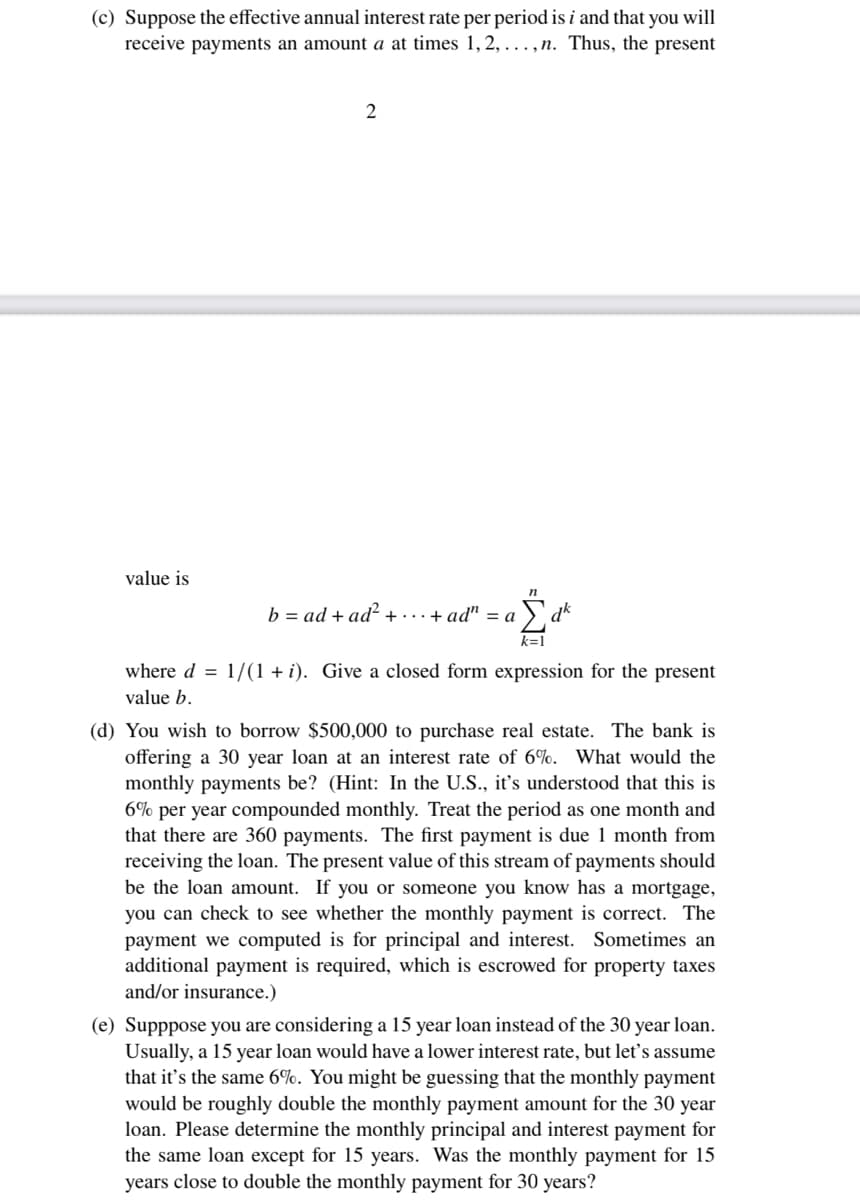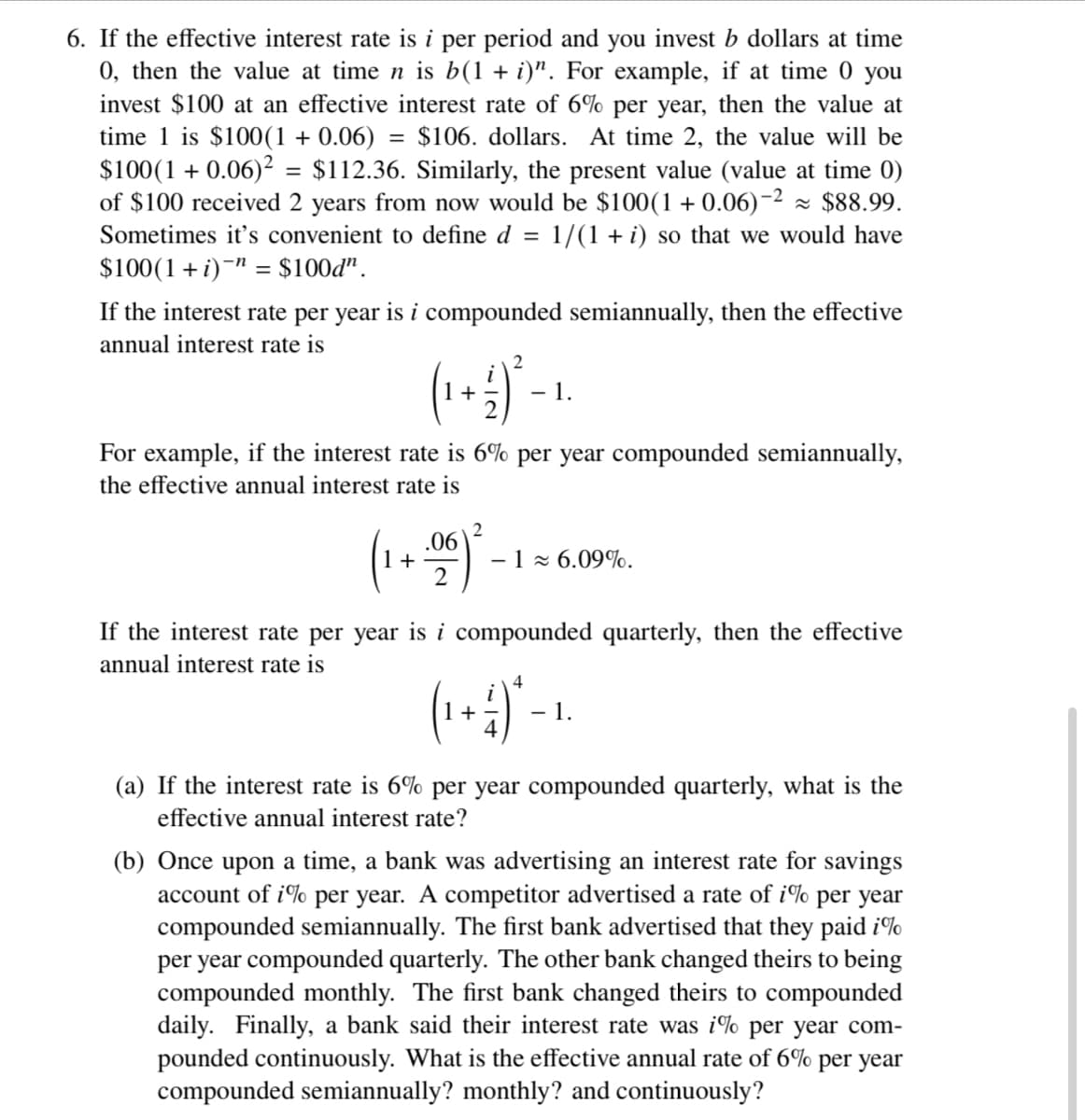(b) Once upon a time, a bank was advertising an interest rate for savings account of i% per year. A competitor advertised a rate of i% per year compounded semiannually. The first bank advertised that they paid i% per year compounded quarterly. The other bank changed theirs to being compounded monthly. The first bank changed theirs to compounded daily. Finally, a bank said their interest rate was i% per year com- pounded continuously. What is the effective annual rate of 6% per year compounded semiannually? monthly? and continuously?
(b) Once upon a time, a bank was advertising an interest rate for savings account of i% per year. A competitor advertised a rate of i% per year compounded semiannually. The first bank advertised that they paid i% per year compounded quarterly. The other bank changed theirs to being compounded monthly. The first bank changed theirs to compounded daily. Finally, a bank said their interest rate was i% per year com- pounded continuously. What is the effective annual rate of 6% per year compounded semiannually? monthly? and continuously?
Financial Management: Theory & Practice
16th Edition
ISBN:9781337909730
Author:Brigham
Publisher:Brigham
Chapter4: Time Value Of Money
Section: Chapter Questions
Problem 12MC: (1) What is the value at the end of Year 3 of the following cash flow stream if the quoted interest...
Related questions
Question
Please respond b, c, d, and e if possible.

Transcribed Image Text:(c) Suppose the effective annual interest rate per period is i and that you will
receive payments an amount a at times 1, 2, ..., n. Thus, the present
value is
2
b = ad + ad²+...+ ad" = a
k=1
where d = 1/(1+i). Give a closed form expression for the present
value b.
(d) You wish to borrow $500,000 to purchase real estate. The bank is
offering a 30 year loan at an interest rate of 6%. What would the
monthly payments be? (Hint: In the U.S., it's understood that this is
6% per year compounded monthly. Treat the period as one month and
that there are 360 payments. The first payment is due 1 month from
receiving the loan. The present value of this stream of payments should
be the loan amount. If you or someone you know has a mortgage,
you can check to see whether the monthly payment is correct. The
payment we computed is for principal and interest. Sometimes an
additional payment is required, which is escrowed for property taxes
and/or insurance.)
(e) Supppose you are considering a 15 year loan instead of the 30 year loan.
Usually, a 15 year loan would have a lower interest rate, but let's assume
that it's the same 6%. You might be guessing that the monthly payment
would be roughly double the monthly payment amount for the 30 year
loan. Please determine the monthly principal and interest payment for
the same loan except for 15 years. Was the monthly payment for 15
years close to double the monthly payment for 30 years?

Transcribed Image Text:6. If the effective interest rate is i per period and you invest b dollars at time
0, then the value at time n is b(1 + i)”. For example, if at time 0 you
invest $100 at an effective interest rate of 6% per year, then the value at
time 1 is $100(1+0.06) = $106. dollars. At time 2, the value will be
$100 (1 + 0.06)² = $112.36. Similarly, the present value (value at time 0)
of $100 received 2 years from now would be $100(1+0.06)-²≈ $88.99.
Sometimes it's convenient to define d = 1/(1 + i) so that we would have
$100(1+i)n = $100d".
If the interest rate per year is i compounded semiannually, then the effective
annual interest rate is
(¹ + 2)²³ - 1₁
1.
For example, if the interest rate is 6% per year compounded semiannually,
the effective annual interest rate is
1 +
.06
2
2
- 1 ≈ 6.09%.
If the interest rate per year is i compounded quarterly, then the effective
annual interest rate is
4
(¹ + 4) * - 1
1.
(a) If the interest rate is 6% per year compounded quarterly, what is the
effective annual interest rate?
(b) Once upon a time, a bank was advertising an interest rate for savings
account of i% per year. A competitor advertised a rate of i% per year
compounded semiannually. The first bank advertised that they paid i%
per year compounded quarterly. The other bank changed theirs to being
compounded monthly. The first bank changed theirs to compounded
daily. Finally, a bank said their interest rate was i% per year com-
pounded continuously. What is the effective annual rate of 6% per year
compounded semiannually? monthly? and continuously?
Expert Solution
This question has been solved!
Explore an expertly crafted, step-by-step solution for a thorough understanding of key concepts.
Step by step
Solved in 4 steps

Knowledge Booster
Learn more about
Need a deep-dive on the concept behind this application? Look no further. Learn more about this topic, finance and related others by exploring similar questions and additional content below.Recommended textbooks for you



Principles of Accounting Volume 2
Accounting
ISBN:
9781947172609
Author:
OpenStax
Publisher:
OpenStax College



Principles of Accounting Volume 2
Accounting
ISBN:
9781947172609
Author:
OpenStax
Publisher:
OpenStax College